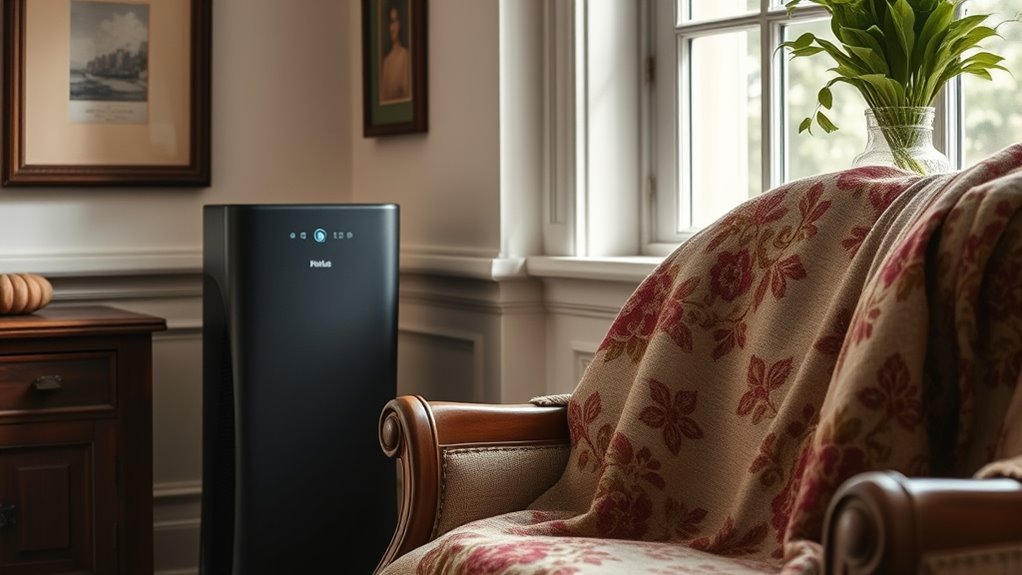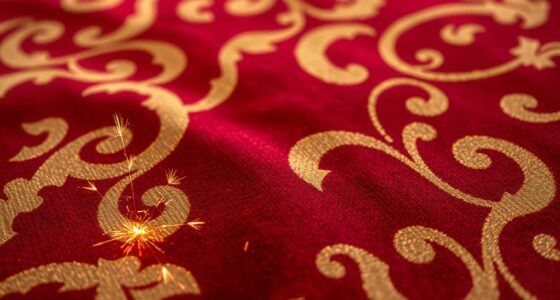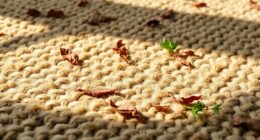Using an air purifier around your antique textiles can considerably reduce dust, pollen, mold spores, and odors that threaten their condition. HEPA filters trap tiny particles, while activated carbon absorbs harmful fumes and musty smells, creating a cleaner environment. Properly chosen and maintained air purifiers help prevent mold growth and fiber deterioration. To protect your collection effectively, you’ll want to explore the best types and how to maximize their use—there’s more to consider for optimal preservation.
Key Takeaways
- Air purifiers remove airborne pollutants like dust, pollen, mold spores, and odors that can damage delicate antique textiles.
- HEPA and activated carbon filters effectively protect textiles by trapping tiny particles and absorbing harmful fumes.
- Properly sized and maintained air purifiers help prevent mold growth and fiber deterioration in antique fabric environments.
- Combining air purification with environmental controls (humidity, temperature) enhances textile preservation.
- Selecting the right unit with features like UV sterilization and low noise ensures safe, continuous protection for vintage fabrics.
Understanding the Risks to Antique Textiles

Antique textiles are especially vulnerable to environmental factors that can cause deterioration over time. Humidity control is vital because excess moisture promotes mold growth and fabric weakening, while low humidity can cause fibers to become brittle. Proper humidity levels are essential to prevent these issues and maintain textile integrity. UV protection is equally important, as ultraviolet rays can fade colors and weaken delicate fibers, accelerating deterioration. Without proper environmental management, exposure to fluctuating humidity and sunlight can considerably reduce the lifespan of your textiles. Over time, these elements lead to discoloration, fiber breakdown, and irreversible damage. Recognizing these risks helps you understand why maintaining stable humidity levels and shielding textiles from UV rays are essential. Additionally, employing advanced automation technologies can help monitor and regulate environmental conditions more precisely. Maintaining environmental stability is crucial to prevent irreversible damage and preserve the integrity of your textiles. Protecting your antiques from environmental harm ensures they stay vibrant and intact for future generations to appreciate.
How Air Purifiers Work and Their Benefits
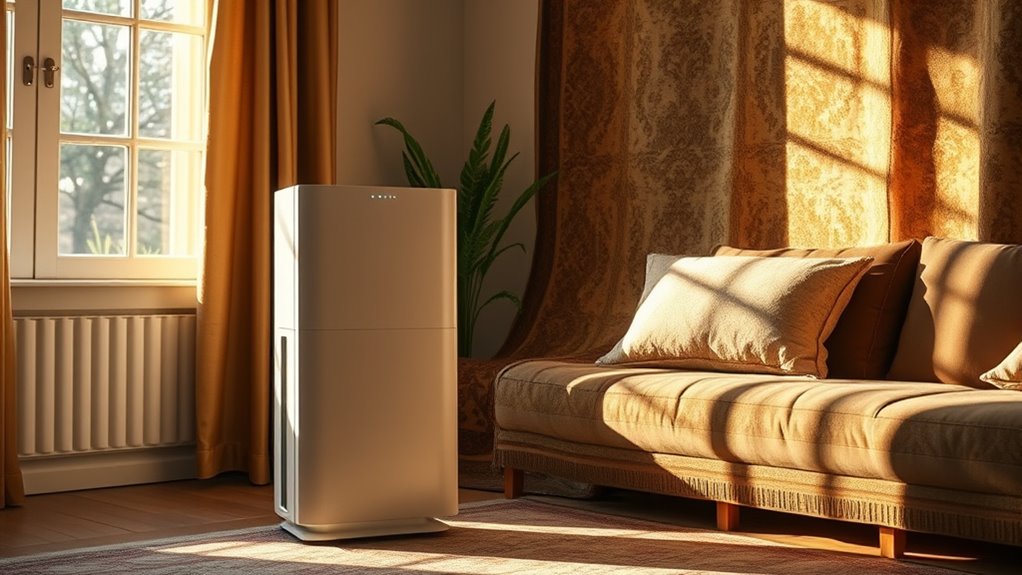
Air purifiers work by drawing in air and filtering out harmful particles, such as dust, pollen, mold spores, and airborne pollutants. They improve indoor air quality, creating a healthier environment for your antique textiles. Regular air purifier maintenance, like changing filters, guarantees ideal performance and keeps the device working efficiently. By reducing airborne contaminants, air purifiers help prevent dust buildup and mold growth that can damage delicate fabrics over time. They are especially useful in spaces where vintage textiles are stored or displayed, as cleaner air minimizes the risk of deterioration. Investing in an air purifier can greatly enhance your indoor environment, protecting your valuable textiles and promoting better respiratory health. Proper maintenance ensures you get maximum benefits from your device. Additionally, choosing an air purifier with a preppy dog names filter can further enhance its ability to capture pet dander and fur, which are common indoor pollutants. Modern models with HEPA filters can effectively remove up to 99.97% of airborne particles, providing comprehensive protection for your textiles. Incorporating an air purifier with advanced filtration technology can further improve air quality and extend the lifespan of your antiques, especially when combined with airflow optimization strategies to enhance coverage and efficiency.
Common Pollutants That Threaten Vintage Fabrics
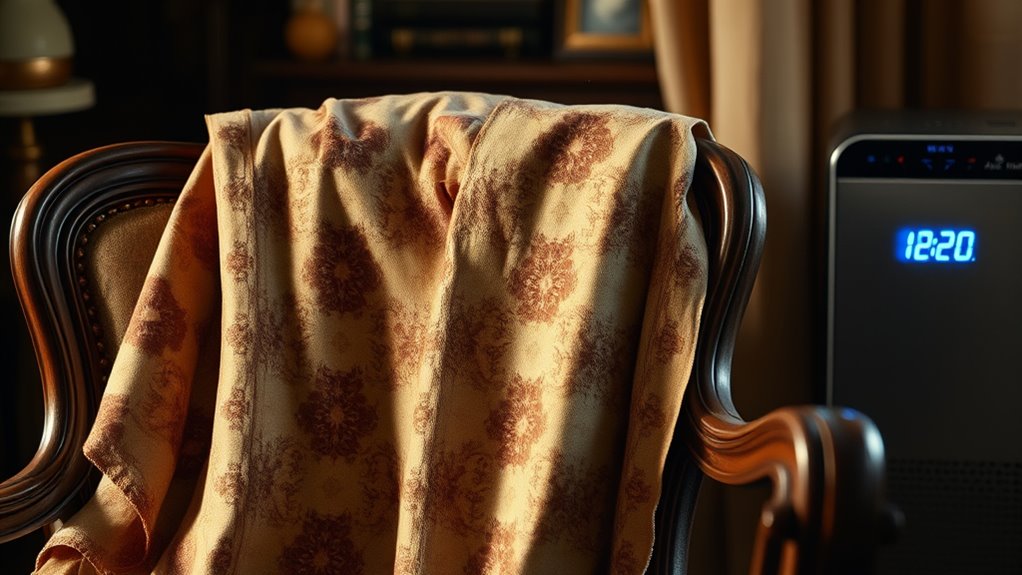
While air purifiers help maintain a cleaner environment for your vintage textiles, understanding the specific pollutants that pose a threat is equally important. Damp odors can create a musty environment, encouraging mold growth that damages delicate fabrics. Pet dander is another common pollutant, especially if you have pets, as it can settle into fibers and cause staining or deterioration over time. Both pollutants can accelerate fabric aging and compromise the integrity of your antique textiles. Airborne particles from smoke, dust, and pollen also contribute to fabric degradation. By targeting these pollutants, a good air purifier can considerably reduce the risks, helping preserve the beauty and value of your vintage textiles for years to come. Additionally, understanding how contrast ratio affects image quality can help you choose better projectors for your home theater setup. Regular maintenance and filter changes are essential to ensure optimal performance of your air purifier in filtering out these harmful pollutants, especially when dealing with airborne particles that can settle into fabrics over time.
Types of Air Purifiers Suitable for Textile Preservation

When choosing an air purifier for textile preservation, HEPA filters are essential because they effectively capture dust, mold spores, and other tiny particles that can damage fabrics. Activated carbon filters add extra protection by absorbing odors, fumes, and pollutants that can accelerate deterioration. Together, these features help create a cleaner environment to safeguard your antique textiles. Incorporating air quality management practices can further enhance preservation efforts by reducing airborne contaminants around your textiles. Additionally, selecting units with appropriate filter types ensures that the air purification process is tailored to protect delicate textiles from specific environmental threats. Regularly monitoring air quality with suitable sensors can help you adjust your preservation strategies and maintain optimal conditions for your textiles. Implementing regular maintenance routines for your air purifier also ensures optimal performance and continued protection for your textiles. Emphasizing data-driven strategies can help you monitor and optimize your preservation environment over time.
HEPA Filter Effectiveness
Are HEPA filters truly effective for preserving antique textiles? Yes, they markedly improve air quality by capturing airborne particles like dust, mold spores, and allergens that can damage delicate fabrics. HEPA filters are highly efficient, trapping particles as small as 0.3 microns, which makes them ideal for protecting fragile textiles from particulate contamination. Additionally, HEPA filters help reduce dark circles and puffiness caused by airborne irritants, further contributing to a healthier environment for your textiles. They also assist in removing airborne pollutants, which can accelerate deterioration of delicate fabrics over time. However, to maintain their effectiveness, regular filter maintenance is essential; clogged filters reduce airflow and filtration efficiency. When choosing an air purifier with a HEPA filter, ensure it’s appropriately sized for the space and designed for continuous operation. Proper filter maintenance helps sustain ideal air quality, minimizing the risk of pollutants settling on your textiles and ensuring their preservation over time.
Activated Carbon Benefits
Have you considered how activated carbon can enhance your textile preservation efforts? Activated carbon captures odors, gases, and volatile organic compounds (VOCs) that can damage antique textiles. Using an air purifier with activated carbon is especially helpful in antique textile restoration, reducing musty smells and harmful pollutants. Proper air purifier maintenance guarantees the carbon remains effective, prolonging its benefits. Here’s a quick comparison of suitable purifier types:
| Feature | Benefits | Ideal For |
|---|---|---|
| Activated Carbon Filter | Absorbs odors and VOCs | Antique textiles, archives |
| HEPA Filter | Traps particles and dust | Allergen reduction |
| Combo Units | Combines filtration types | Comprehensive preservation |
| UV Light | Kills bacteria and mold | Humid environments |
| Ionic Purifiers | Cleans air via ionization | Moderate odor control |
Factors to Consider When Choosing an Air Purifier
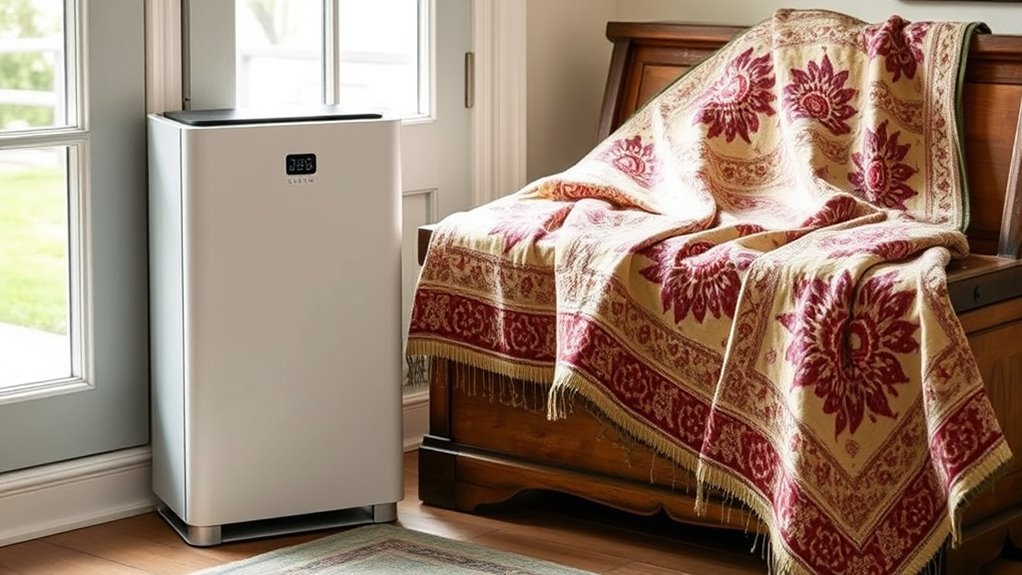
Choosing the right air purifier involves considering several key factors to guarantee it meets your needs. First, evaluate your air quality concerns—whether you’re targeting dust, pollen, odors, or airborne pollutants. This helps determine the purifier’s filtration capabilities, such as HEPA filters for allergens or activated carbon for smells. Next, consider filter maintenance; some units require frequent filter replacements, which can affect long-term costs and convenience. Look for models with easily accessible filters and clear maintenance instructions. Noise level is also important—ensure it won’t disturb your space. Size and room coverage matter too; pick an air purifier suited to the size of the area you want to purify. By weighing these factors, you’ll select a device that effectively improves air quality while fitting your lifestyle.
Potential Drawbacks of Using Air Purifiers Around Antiques
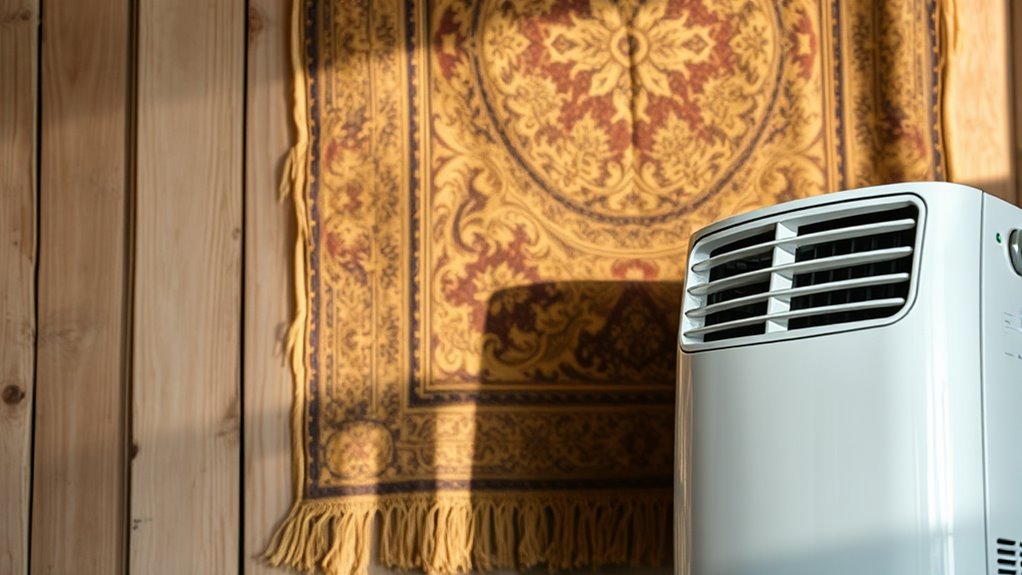
While air purifiers can improve indoor air quality, they may pose risks to antique textiles if not used carefully. Some models release chemical residues from filters or cleaning agents, which could settle on delicate fabrics and cause deterioration over time. Additionally, many air purifiers generate noise levels that can disturb the quiet environment needed to preserve antiques. High noise levels may also lead you to disable or move the unit frequently, reducing its effectiveness. If you choose an air purifier, opt for those designed with low-emission filters and quiet operation. Always position the device away from fragile textiles to minimize exposure to chemical residues and avoid interference from noise. Proper selection and placement are key to protecting your antiques while benefiting from cleaner air.
Complementary Strategies for Textile Care and Preservation
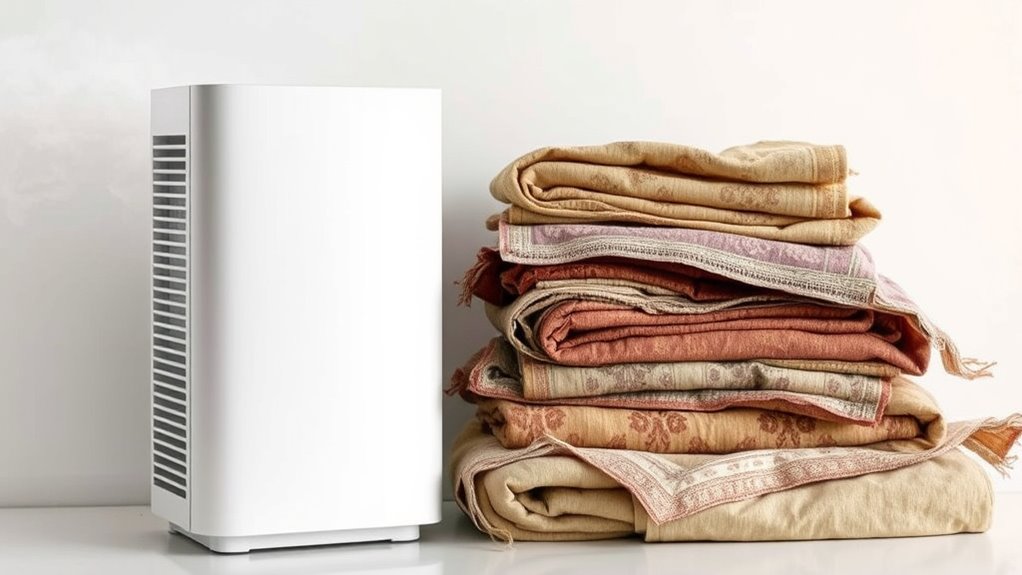
To effectively preserve antique textiles, combining proper handling with environmental control is essential. You should regularly perform environmental monitoring to catch fluctuations that could damage delicate fabrics. Humidity control plays a vital role; aim to keep humidity levels steady—around 50%—to prevent mold, brittleness, or deterioration.
Consider these strategies to evoke emotional preservation:
Prioritize gentle handling and climate control to emotionally preserve your treasured textiles.
- Protect your textiles from sudden temperature shifts that cause stress and cracks
- Handle fabrics with care, avoiding unnecessary contact or stress
- Store textiles in acid-free, climate-controlled environments to safeguard their history
Implementing these complementary measures ensures your antique textiles remain vibrant and intact for future generations. Remember, a thoughtful approach goes beyond just air quality—it’s about nurturing history.
Practical Tips for Maintaining a Clean Environment

To keep your environment clean and protect your antique textiles, start with regular cleaning routines that remove dust and dirt. Make sure you have proper ventilation to reduce humidity and airborne pollutants. Additionally, choose air purifiers that are suitable for your space to effectively filter out allergens and particles.
Regular Cleaning Routines
Establishing a regular cleaning routine is essential for maintaining a healthy and dust-free environment, especially when caring for antique textiles and air purifiers. Consistent dusting and vacuuming help reduce dust mites that thrive in fabric fibers, minimizing allergic reactions. Keep an eye out for mold growth, which can develop in humid areas and damage delicate textiles. Regularly inspecting and cleaning your textiles prevents mold from settling and spreading. Using gentle cleaning methods preserves their integrity.
- Visualize the soft fabrics free of dust, feeling fresh and vibrant.
- Imagine the relief of preventing mold damage before it starts.
- Feel confident knowing you’re protecting your valuable antiques and your health.
Proper Ventilation Practices
Maintaining a clean environment isn’t just about regular cleaning—proper ventilation plays a key role in preventing moisture buildup and reducing airborne pollutants. Good airflow helps control humidity, which protects antique textiles from mold and mildew. Keep your space well-ventilated by opening windows when weather permits or using exhaust fans in high-moisture areas like kitchens and bathrooms. Proper ventilation also discourages pests, which are attracted to damp, stagnant environments. Ensure vents are unobstructed and consider using fans or air circulators to promote air exchange. Maintaining low humidity levels and fresh air reduces the risk of pest infestations and mold growth, helping preserve your textiles’ integrity. Consistent ventilation is a simple yet effective step in creating a healthier, safer environment for your antiques.
Choosing Suitable Air Purifiers
Selecting the right air purifier is vital for effectively reducing pollutants and maintaining a clean environment, especially when preserving delicate antiques like textiles. Look for units that offer humidity control to prevent mold and mildew growth, which can damage fabrics. UV protection is also essential to shield your textiles from harmful ultraviolet rays that cause fading and deterioration. Consider models with HEPA filters to trap dust and allergens, and ensure they have adjustable settings for tailored use.
- Feel confident knowing your textiles are protected from environmental threats
- Enjoy peace of mind that harmful particles won’t threaten your cherished items
- Maintain a stable environment that preserves the beauty and integrity of your antiques
Making an Informed Decision for Your Collection
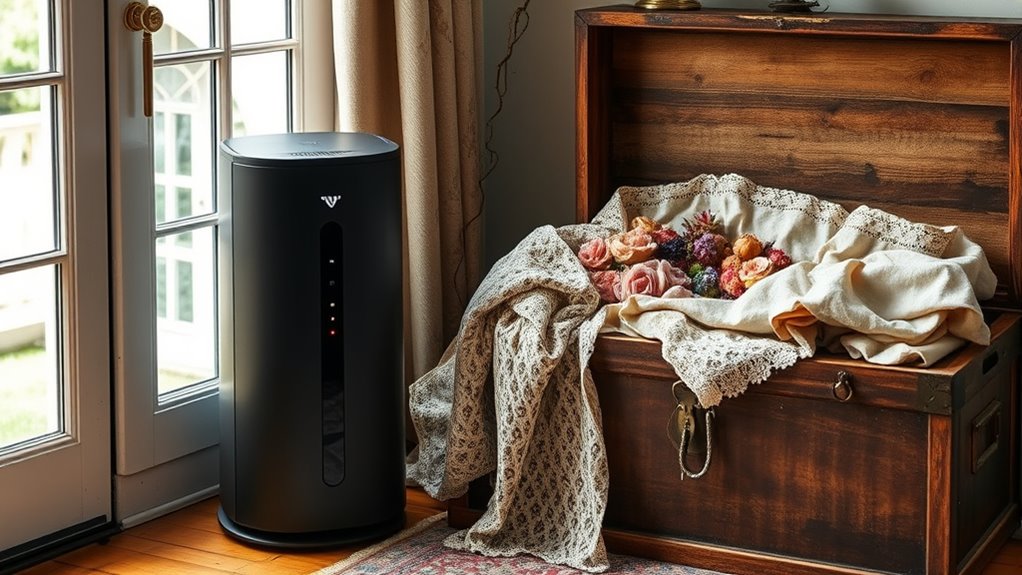
When choosing an air purifier for your antique textiles, it’s essential to contemplate both the device’s specifications and the unique needs of your collection. Consider features like humidity control to prevent mold and pest prevention to keep insects at bay. These elements help maintain the integrity of your textiles over time. To make an informed decision, evaluate these factors:
| Feature | Why It Matters | What to Look For |
|---|---|---|
| Humidity Control | Protects against mold and rot | Adjustable settings, hygrometer |
| Pest Prevention | Keeps insects from damaging textiles | HEPA filters, insect-repelling features |
| Quiet Operation | Ensures undisturbed preservation | Low noise levels |
Balancing these considerations ensures your collection stays preserved and safe.
Frequently Asked Questions
Can Air Purifiers Prevent Mold Growth on Antique Textiles?
You might wonder if air purifiers can prevent mold growth on antique textiles. While they can help by reducing airborne mold spores and pollutants, they aren’t a complete solution for mold prevention. To preserve textiles, focus on controlling humidity, ensuring proper ventilation, and storing items in a cool, dry environment. Using an air purifier can be part of your preservation strategy, but it’s crucial to combine it with other mold prevention measures.
Do HEPA Filters Effectively Remove All Types of Pollutants From Antique Storage Areas?
Did you know HEPA filters remove 99.97% of particles as small as 0.3 microns? While they’re effective for allergen removal, HEPA limitations mean they don’t eliminate gases, odors, or volatile organic compounds (VOCs). So, in antique storage areas, HEPA filters help reduce dust and pollen but won’t remove all pollutants. For complete protection, consider combining HEPA with activated carbon filters.
How Often Should I Replace or Clean My Air Purifier Filters for Textile Safety?
You should perform regular filter maintenance and follow the replacement frequency recommended by your air purifier’s manufacturer. Typically, filters need cleaning or replacing every 3 to 6 months, but this varies based on usage and air quality. For textile safety, check filters more often if you notice dust or odors. Proper maintenance guarantees your purifier effectively captures pollutants, protecting your textiles and maintaining a healthy environment.
Are There Specific Air Purifier Features Best Suited for Antique Textile Preservation?
Preservation perfection requires careful consideration of features. You should seek an air purifier with superb humidity control to prevent mold and damage, while low noise levels keep your space peaceful. Look for units with sensitive sensors and customizable settings, ensuring your antique textiles stay pristine. Prioritizing these features allows you to protect your treasures effortlessly, creating a safe, serene sanctuary for your cherished textiles.
Can Air Purifiers Cause Any Damage or Discoloration to Delicate Fabrics?
You might wonder if air purifiers can cause fabric discoloration or textile damage. Generally, high-quality purifiers with proper filters won’t harm delicate fabrics. However, some models emit ozone or produce strong airflow that could lead to fabric discoloration or damage over time. To protect your textiles, choose an air purifier specifically designed for sensitive environments and avoid models with ozone generators or powerful, direct airflow.
Conclusion
While it might seem like adding an air purifier is just another expense, it’s a smart step to protect your vintage textiles from harmful pollutants. Don’t worry—using one doesn’t mean your collection will feel sterile or lifeless. With the right choice and proper care, you can enjoy your antiques for years to come, knowing they’re shielded from unseen dangers. After all, your treasured textiles deserve the best care possible.
